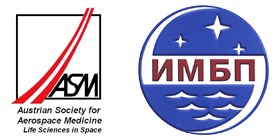“RLF” (Russian Longterm-Flight) was a common Austrian-Russian research project in the area of spaceflight physiology and medicine. Based on the experiences and developments through the AUSTROMIR-91 project, it brought partially unexpected, new bio-medical results in the years 1993 up to 1997.
The cosmonaut Dr. Valeri Vladimirovich Poljakov, a doctor, was chosen for the execution of this long-term flight. The time of his sojourn onboard the MIR space station and therewith also the RLF project was divided into a total of three phases:
| first Phase (RLF-1): | 8 January 1994 to 9 July 1994 |
| second Phase (RLF-2): | 1 July 1994 to 4 November 1994 |
| third Phase (RLF-3): | 4 October 1994 to 22 March 1995 |
The core team, that is, the commander and the engineer, was changed each phase. Additionally, in the 4-week period overlapping the second and third phases, the sojourn of a guest cosmonaut of the European Space Agency (ESA) and a female cosmonaut in the third phase was arranged.
In order to present the results worldwide and deepen the contacts of the experimenters with the international scientific community, the Austrian Society for Aerospace Medicine (ASM) organized a special conference in 1996 on the occasion of the annual convention of the Aerospace Medical Association in Atlanta, Georgia, USA, on invitation of the American organizer and with wide international interest.
RLF was a historical project because it examined long-term missions, whose goal is the preparation for the discovery and settlement of the moon and Mars; and because it encompassed the longest human space-flight that ever took place.
